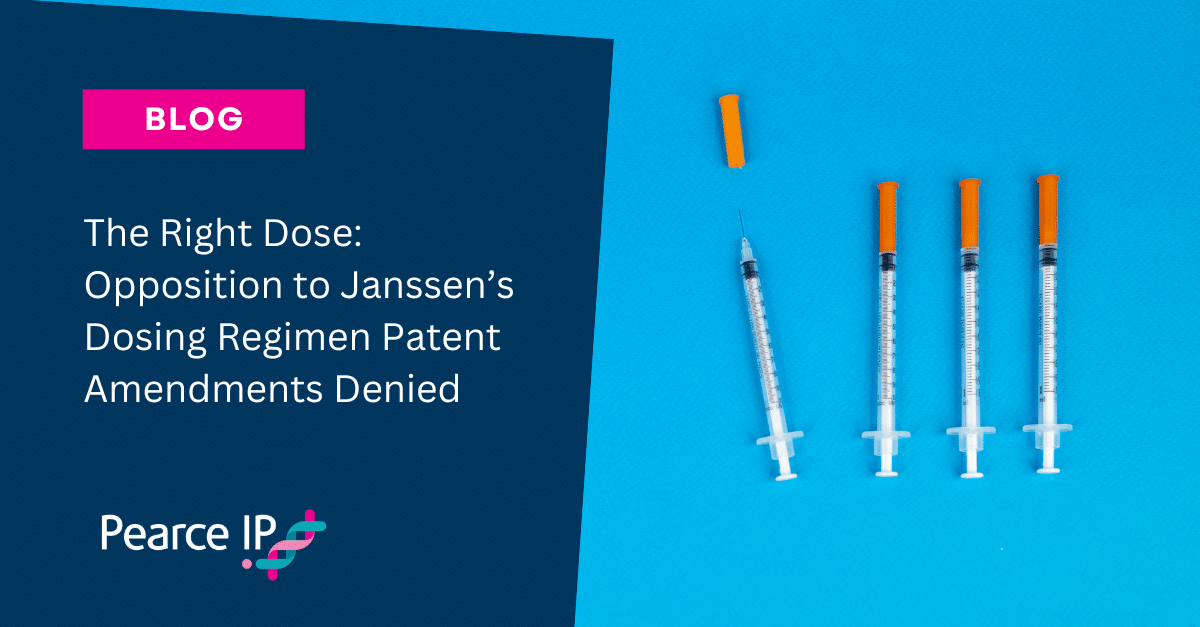| Date of decision: | 4 December 2024 |
| Body: | Australian Patent Office |
| Adjudicator: | Dr S. J. Smith |
Highlight
In a December 2024 decision, the Australian Patent Office has dismissed Juno Pharmaceuticals’ (Juno) opposition to amendments sought by Janssen Pharmaceutica NV (Janssen) for its patent covering dosing regimens for long-acting injectable paliperidone esters. The Delegate allowed the amendments and awarded costs against Juno, finding that the proposed amendments complied with sections 102(1) (amended claims falling within the scope of the ‘as filed’ specification), 102(2)(a) (amended claims falling within the scope of the ‘accepted’ claims), and 102(2)(b) (the amended claims being fairly based on the specification) of the Patents Act 1990.
Background
In December 2008, Janssen filed patent AU2008340101 (the Patent) entitled ‘dosing regimen associated with long acting injectable paliperidone esters’. The Patent outlines a dosing regimen for injectable paliperidone palmitate, based on research demonstrating that the drug exhibits “flip-flop kinetics” and achieves better results with injections into the deltoid muscles. The specification recommends a regimen involving two initial deltoid injections on day one and between days 6-10 (loading doses of 100 – 150 mg-eq), followed by monthly maintenance doses of 25-150 mg-eq.
The Patent was granted in December 2015, and Janssen sought leave to amend the specification in February 2023, with those amendments being superseded by further amendments in May 2023. Juno subsequently filed an opposition in August 2024.
Key Issues and Consideration
The Delegate’s analysis centred on two main categories of amendments: (i) Extension of Loading Dose Ranges; and (ii) Method of treatment claims.
Extension of Loading Dose Ranges
Janssen sought to amend claim 1 as follows:
a first loading dose of from about 100mg-eq. to about 150 mg-eq. of paliperidone”
and
“a second loading dose of from about 100mg-eq. to about 150 mgeq. of paliperidone.
Juno argued that prior to amendment, the skilled person would understand claim 1 to include administration of a first and second loading dose of at least 100 mg eq. (but not less than that) up to no more than 150 mg eq. However, post-amendment, Juno argued that claim 1 would be understood as allowing doses above and below 150 and 100 mg eq., so broadening the scope of the claim. Janssen submitted that “about” in the original claims meant “approximately”, arguing this interpretation was logical since any other reading would make the word “about” redundant. The expert evidence was divided on this issue: Juno’s expert, Professor Keks, interpretated the range as having strict limits due to the word “from”, while Janssen’s expert, Professor Singh, viewed “about” as consistently meaning “approximately” throughout the specification, allowing for marginal variations above and below the stated values.
The Delegate agreed with Janssen, noting that the Full Court in Pharmacia LLC v Juno Pharmaceuticals Pty Ltd [2022] FCAFC 167 observed that it is “axiomatic that a claim term should be construed consistently throughout the claim set”, and that giving “about” different meanings when used in a range (or prefaced by “from”) versus specific integers would be an unnatural construction. As such, this amendment could not have the effect of broadening the scope of the claims.
Juno also argued that the specification did not disclose the selection of the two specific doses to which the amendments were directed (where the first loading dose was amended to the upper limit and the second to the lower limit of their original ranges). Juno further submitted that the amended claims would allow maintenance dosing (25-150 mg eq.) to exceed the second loading dose (100 mg eq.), contradicting both the specification’s statement about doses “dropping to” maintenance levels and the dictionary definition of “loading dose”, being “an initial dose of a drug which is higher than subsequent doses, intended to rapidly achieve a therapeutic concentration in the body”. The Delegate preferred Janssen’s position, finding that, since the specific doses fell within the original ranges, they represented a permissible narrowing amendment, and there was no clear indication in the specification that a maintenance dose must be lower than a loading dose, irrespective of the dictionary definition.
Finally, Juno argued that amended claims 6 and 7, which specified a 100 mg eq. first loading dose for renally impaired patients, lacked support in the specification, which stated that renally impaired patients’ loading doses “should be reduced to 75 mg eq. for the first two loading doses”. However, the Delegate found against Juno on the basis that the administration of a first loading dose of about 100 mg eq. of paliperidone to a renally impaired patient was not introduced by Janssen’s amendment.
Method of treatment claims
The second major category of amendments concerned new method of treatment claims (claims 45-54). These claims defined methods of treating psychiatric patients by administering paliperidone palmitate according to selected preceding claims. Juno argued that these amendments exceeded the scope of both the original dosing regimen claims (discussed above), and claim 25 prior to amendment (a “use” claim), which reads:
Use of paliperidone palmitate in a dosage regimen according to any one of claims 1 to 23 for treating a psychiatric patient, or a renally impaired psychiatric patient.
In support, Juno submitted that:
- a dosing regimen is not a method of treatment, but a list of instructions for administration (which in and of itself did not treat the patient). Based on this distinction, Juno argued that the amendment broadened the scope of the claims such that an infringement would occur which would not have occurred pre-amendment; and
- the original claim 25 was limited to cases where paliperidone was used with the regimen instructions (even suggesting that “use” could be satisfied by merely writing paliperidone on a list of drugs to be used according to the regimen), rather than requiring actual administration to patients.
In response, Janssen submitted that:
- “use” constitutes an act of exploitation;
- the dosing regimen claims properly construed are method claims as they define administration steps;
- the appropriate comparison is between each amended claim and the unamended claims as a whole; and
- following the decision in AMP Incorporated v Commissioner of Patents (1974) 3 ALR 283, “it is not necessary before an amendment is allowed to find that the amended claim would actually fall within the scope of one or all of the other claims. It need only fall in substance within that scope”, and there was no basis in the specification or evidence to understand claim 25 prior to amendment to require the exclusive use of the defined dosage regimen for treating a psychiatric patient.
The Delegate considered it unnecessary to turn to the dosage regimen per se claims to decide this issue. The Delegate found that claim 25 prior to amendment, which covered “use … for treating a patient”, must include actual drug administration since it referenced regimens specifically designed for administering the drug and detailed specific administration steps. The Delegate also took the opportunity to confirm that, in any event, the intention of the person carrying out the administering is irrelevant to the scope of method of treatment of dosage regimen claims.
Outcome and Implications
The Delegate denied the opposition, finding that Juno failed to establish that the amendments did not comply with ss 102(1), 102(2)(a) or 102(2)(b) of the Patents Act. The Delegate’s decision reinforces the fundamental principles of claim construction, with the Delegate giving a logical and consistent interpretation to the claims before and after amendment.
About Pearce IP
Pearce IP is a boutique firm offering intellectual property specialist lawyers, patent attorneys and trade mark attorneys to the life sciences industries (in particular, pharmaceutical, biopharmaceutical, biotech, ag-tech and food tech). Pearce IP is the 2021 ‘Intellectual Property Team of the Year’ (Lawyers Weekly Australian Law Awards) and was shortlisted for the same award in 2022. Pearce IP is ranked in IAM Patent 1000 and Managing IP (MIP) IP Stars, in Australasian Lawyer 5 Star Awards as a ‘5 Star’ firm, and the Legal 500 APAC Guide for Intellectual Property.
Our leaders have been recognised in virtually every notable IP listing for their legal, patent and trade mark excellence including: IAM Patent 1000, IAM Strategy 300, MIP IP Stars, Doyles Guide, WIPR Leaders, 5 Star IP Lawyers, Best Lawyers, and Australasian Lawyer 5 Star Awards, and have been honoured with many awards including Australian Law Awards – IP Partner of the Year, Women in Law Awards – Partner of the Year, Women in Business Law Awards - Patent Lawyer of the Year (Asia Pacific), Most Influential Lawyers (Changemaker), among other awards.

Naomi Pearce
CEO, Executive Lawyer (AU, NZ), Patent Attorney (AU, NZ) & Trade Mark Attorney (AU)
Naomi is the founder of Pearce IP, and is one of Australia’s leading IP practitioners. Naomi is a market leading, strategic, commercially astute, patent lawyer, patent attorney and trade mark attorney, with over 25 years’ experience, and a background in molecular biology/biochemistry. Ranked in virtually every notable legal directory, highly regarded by peers and clients, with a background in molecular biology, Naomi is renown for her successful and elegant IP/legal strategies.
Among other awards, Naomi is ranked in Chambers, IAM Patent 1000, IAM Strategy 300, is a MIP “Patent Star”, and is recognised as a WIPR Leader for patents and trade marks. Naomi is the 2023 Lawyers Weekly “IP Partner of the Year”, the 2022 Lexology client choice award recipient for Life Sciences, the 2022 Asia Pacific Women in Business Law “Patent Lawyer of the Year” and the 2021 Lawyers Weekly Women in Law SME “Partner of the Year”. Naomi is the founder of Pearce IP, which commenced in 2017 and won 2021 “IP Team of the Year” at the Australian Law Awards.

Helen Macpherson
Executive, Lawyer (Head of Litigation –Australia)
Helen has over 25 years’ experience as an intellectual property specialist and is recognised as an industry leader. Helen advises on all forms of intellectual property including patents, plant breeder’s rights, trade marks, copyright and confidential information.
Throughout her career, Helen has maintained a strong focus on high-value patent mandates involving complex technologies. In these mandates, Helen has been able to draw upon her technical training in biochemistry and molecular biology, as well as her ability to up-skill swiftly in relation to diverse technologies. Helen’s patent work has encompassed the technical fields of inorganic, organic, physical and process chemistry, biochemistry, biotechnology (including genetics, molecular biology and virology) and physics.
Helen is a member of the Intellectual Property Committee of the Law Council of Australia, as well as a member of the Intellectual Property Society of Australia and New Zealand.

Nathan Kan
Law Graduate
Nathan is a law graduate focused on providing services and advice to life sciences clients, with a focus on litigation support regarding intellectual property (patents, trade marks, designs, copyright, domain names, plant breeders rights and confidential information) and commercial disputes.
Nathan is passionate about the intersection of law and science. Whilst serving as Sponsorship Director and subsequently as Vice President of the Science and Technology Law Association (SATLA) at the University of Melbourne, he led various engagement events, workshops and publications covering a range of STEM fields, including life sciences, artificial intelligence and digital transformation.

